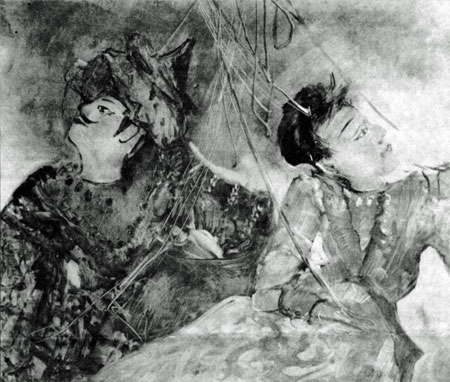Bohlen's Puppets Inspire, Watch Over Her Striking Monotypes
by Kim Cannon, The Times Record, 1993
GEORGETOWN — It’s not often that an entire group of artist’s subjects are able to attend an exhibition. But some of Nina Bohlen’s subjects will be hanging around to meet visitors at the Anne Weber Gallery, where the show continues through the end of the month.
“They” — and some of their friends — are the exquisite puppets from which Bohlen has drawn the inspiration for a striking series of monotypes. Handcrafted in mysteriously exotic locals like Burma and Indochina, the puppets are elaborately costumed and painted. Their bodies are carved from wood and jointed together in enough places to give the holder of the strings control over an eerily complete range of motion. Many of these marionettes hang from a wooden rack in the largest room. Others stand watch in nooks around the rest of the gallery.

The best of Bohlen’s monotypes combine the rich, subtle colors she chooses with the fragility of the puppets and the design and tension created by their various poses and forms. (She uses oil paints rather than printer’s ink, which gives her works a slightly different feel.) She further embellishes and strengthens the images at times by etching the puppet’s strings onto the image.
As metaphors for humans and human relationships, the puppets have both whimsical and dark sides. In “Separate Worlds,” the lovely colors, pretty faces and ornate costumes quickly belie the fact that the male and female puppets, while close together, are facing and staring in opposite directions.
“Separate Ways” has a similar theme, with puppets of opposite sexes positioned close enough to kiss one another. Despite the overt intimacy, the two make no eye contact.
A pair of devilishly painted puppets star in two pieces which represent conflict so fierce it is almost funny. In the first, the aggressor is behind the other, his slit of a mouth and arched eyebrows a caricature of the sarcastic and sardonic. He is taking obvious delight in torturing the vampire-faced puppet with huge bugeyes and a yellow toothed grimace. The first puppet’s fingerless hands seem to be pulling on strings coming from or attached to the ears of his victim. In the second print, he appears to be reaching up to stab his nemesis who floats to the top of the piece in a horizontal levitation.
Even alone, Bohlen’s puppets can generate powerful emotions. “Chinese Puppet,” a single color monotype is a very strong piece, beautiful in its simplicity, frightening in the loneliness it portrays. A sheet of white comes between the puppet and an edge of blackness. He is positioned in the lower left corner, pressed upon by the weight of space above and in front of him. Another, this one done in shades of red with etched lines bringing back the white of the paper, is called “Hanging Puppet with Burmese Ox.” This very disturbing work shows the puppet strangled by a noose of its own strings. The face and hands are white. The lifeless head bends horizontally. The puppet is lightly resting on the outline of the reclining bull, but you get the feeling that if there were a breeze, the body would swing.
Puppets bold a fascination for artists, photographers and film makers for a variety of reasons. Kven the most benignly painted expression ties them to a particular emotion. When juxtapositioned with posture or situation, that emotion can seem either natural, ironic or hideous. Bohlen knows this and uses it well.
There are other works here, most of them done between 1981 and 1991. Among the most notable is a monotype called “Landscape Venezuela.” The darkly purple landscape is shaped and textured by thick strokes above the horizon and white birds silhouetted by the absence of color. The stark, thin tree branches are complemented by the legs and beaks of the water birds. For a study of a Great Blue Heron, Bohlen takes sonic liberty with the natural shape of the bird, contorting it so that the long strokes of the feathers frame the lovely long neck and a beak just touched with green-gold highlights.
Bohlen has exhibited her works since 1959. Her most recent shows include a 1992 group exhibition at the Little Rock Art Association in Little Rock and solo exhibits at the Boston Public Library and the University of Maine, also in 1992. Her work is in the permanent collections of the Fogg Art Museum at Harvard.
-Kim Cannon